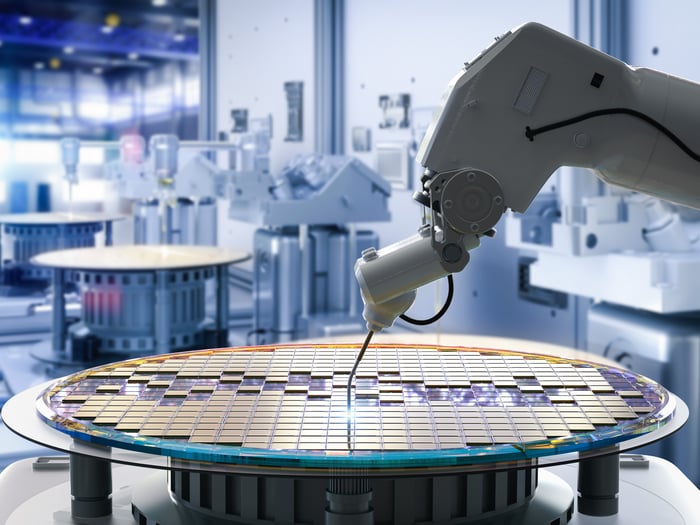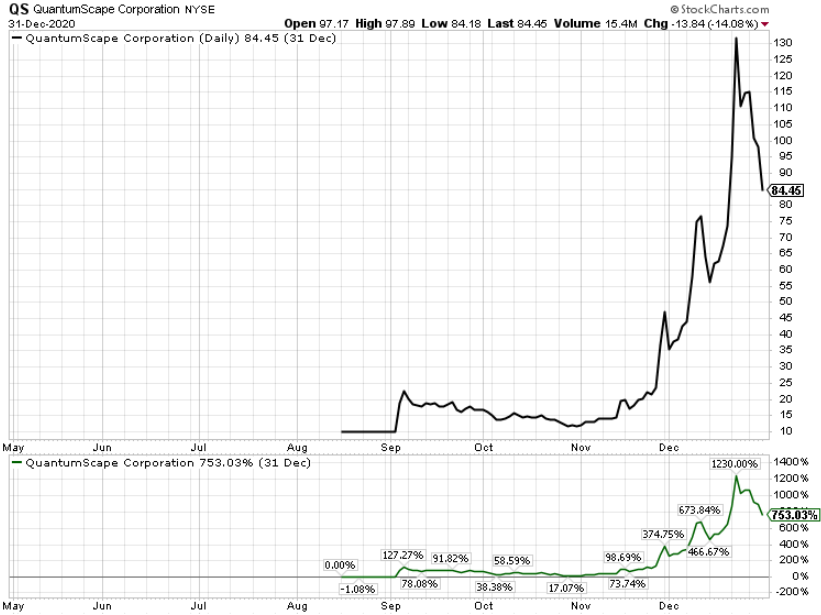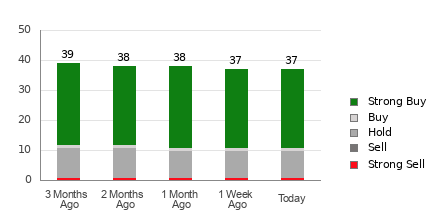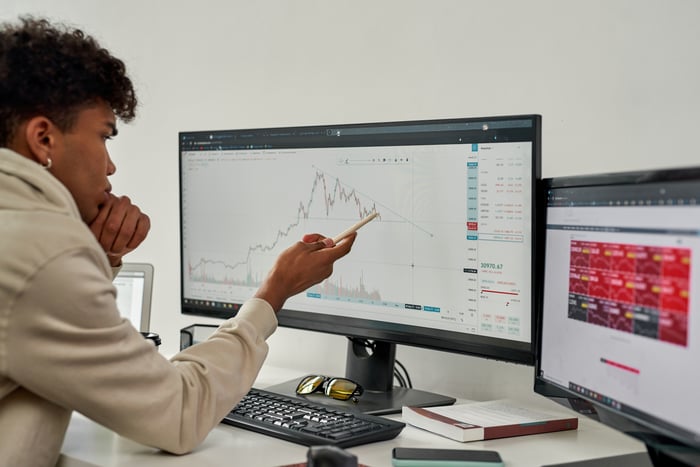Unlocking the AI Revolution: Understanding its Value Chain and Investment Opportunities
The artificial intelligence (AI) revolution is transforming how we process information, make decisions, and develop infrastructure, extending well beyond chatbots and automation. As reported by the International Data Corporation, global spending on AI could reach an impressive $500 billion by 2024. Investors must grasp how each element of the AI value chain supports and enhances the next to seize this unique investment opportunity.
A holistic perspective on the AI value chain—from foundational computing power to innovative applications—gives investors crucial context to evaluate the far-reaching effects and strategic significance of the AI surge. Real-world applications are already being implemented, such as Japan’s recent collaboration between Nvidia (NASDAQ: NVDA) and third-largest telecom operator SoftBank. This partnership aims to expedite the establishment of AI infrastructure across sectors like robotics, automotive, healthcare, and telecom, showcasing a practical example of the entire value chain in action.

Image Source: Getty Images.
While Japan’s initiative provides valuable insight into the large-scale deployment of the AI value chain, the overall narrative highlights a landscape of interconnectedness and collaboration. Innovations in one area can unlock new opportunities in others. For investors, understanding this web of interactions is vital for uncovering potential and managing risks as AI continues to permeate diverse industries in the future.
Next, we will explore the essential components of the AI revolution, encompassing processing power, algorithm creation, and tangible applications. By pinpointing key players and pioneers within each layer of the value chain, investors can gain actionable insights to take advantage of this technological shift. Additionally, for those looking for diverse investment options, we’ll review the top 10 AI-themed exchange-traded funds (ETFs) that can offer efficient exposure to this expanding market.
Computing Foundations: The Power Behind AI
The AI revolution begins with raw computing power. Nvidia currently leads the AI chip market, holding an estimated 80% to 95% share in AI accelerators, according to various analysts. The company’s H100 Graphics Processing Unit (GPU), priced up to $40,000 per unit, has set the standard for training large language models. In the first three quarters of fiscal 2025, Nvidia’s data center revenue reached nearly $80 billion, with Q3 alone contributing $30.8 billion, demonstrating the high demand for its AI-capable GPUs.
Advanced Micro Devices (AMD) (NASDAQ: AMD) has also emerged as a notable competitor with its MI300 accelerators, integrating CPU and GPU functions on a single chip. Initial performance benchmarks indicate AMD’s products rival Nvidia’s while potentially consuming less power. Currently, AMD commands less than 10% of the market, but major cloud providers like Microsoft (NASDAQ: MSFT) and Meta Platforms are set to deploy MI300 chips in their infrastructures.
Intel (NASDAQ: INTC)
The Rise of AI Infrastructure: Key Players and Stock Performance in 2024
As AI technology continues to evolve, companies are adopting various strategies to capture this lucrative market. Intel, for one, is focusing on a multifaceted AI strategy that includes its Gaudi 3 AI accelerators aimed at budget-conscious customers and the next-generation Meteor Lake CPUs, which feature neural processing units for on-device AI applications. Despite substantial investments in new manufacturing facilities, Intel has faced challenges in rapid execution, resulting in disappointing quarterly outcomes and the recent exit of former CEO Pat Gelsinger.
Taiwan Semiconductor Manufacturing Company (NYSE: TSM) is a key player in producing many advanced processors, including Nvidia’s H100 and AMD’s MI300. With plans to shift to 2nm manufacturing by 2025, TSMC is poised to enhance its processing capabilities significantly.
The AI chip market is not limited to traditional processors. Broadcom (NASDAQ: AVGO) specializes in networking chips vital for connecting AI systems, while Marvell (NASDAQ: MRVL) creates custom AI accelerators tailored for applications like automotive and 5G infrastructure.
Lam Research (NASDAQ: LRCX) supplies essential semiconductor manufacturing equipment needed for the etching and deposition processes critical in producing sophisticated AI chips.
Nebius Group (NASDAQ: NBIS), previously known as Yandex, has evolved into a comprehensive AI infrastructure company based in Europe. Its AI-focused cloud platform is tailored for demanding workloads. The company also offers data services via Toloka AI and autonomous driving technology through Avride, positioning itself as a significant competitor in the AI infrastructure space, especially in Europe.
Below is an overview of the stock performance for companies in the computing foundations sector for 2024.
|
Company |
Stock Performance YTD (%) |
|---|---|
|
Nvidia |
187.6 |
|
AMD |
(5.98) |
|
Intel |
(58.3) |
|
TSMC |
95.2 |
|
Broadcom |
60.8 |
|
Marvell |
88.2 |
|
Lam Research |
(2.22) |
|
Nebius Group |
94.1 |
|
Segment average |
57.4 |
Performance data covers Jan. 1 to Dec. 6, 2024.
Rising Power Infrastructure Needs
The explosive growth in AI computing is creating significant energy demands. Currently, data centers consume around 2% of the electricity in the U.S., a number that is expected to rise to 4% by 2026. The energy required for AI workloads is far greater than that of conventional computing tasks. This increasing power consumption is sparking a renewed interest in nuclear energy solutions, particularly advanced reactor designs from companies like Oklo (NYSE: OKLO) and NuScale Power (NYSE: NU).
Constellation Energy (NASDAQ: CEG) stands out in the traditional nuclear sector, with a robust fleet of high-capacity reactors ready to meet immediate AI power needs. Oklo’s compact fast reactor and NuScale’s small modular reactor technology aim to address the distributed energy requirements of future data centers. The International Atomic Energy Agency predicts that the first commercial operations of small modular reactors could commence by 2030, in line with objectives set by NuScale and Oklo.

Image Source: Getty Images.
The power challenges posed by AI advancement present opportunities for investors in nuclear energy. Constellation Energy provides stable returns with growth potential driven by AI. In contrast, next-gen companies like Oklo and NuScale offer higher-risk investments in groundbreaking technologies. Given the crucial role of power infrastructure in AI deployment, the demand for affordable, reliable, and carbon-free nuclear energy solutions is likely to remain high.
Here’s a look at stock performance for companies in the AI energy and infrastructure segment in 2024.
|
Company |
Stock Performance YTD (%) |
||||||||||||||||||||||||||||||||||||||||||||||||||||||||||||||||||||||||
|---|---|---|---|---|---|---|---|---|---|---|---|---|---|---|---|---|---|---|---|---|---|---|---|---|---|---|---|---|---|---|---|---|---|---|---|---|---|---|---|---|---|---|---|---|---|---|---|---|---|---|---|---|---|---|---|---|---|---|---|---|---|---|---|---|---|---|---|---|---|---|---|---|---|
|
Constellation Energy |
117.0 |
||||||||||||||||||||||||||||||||||||||||||||||||||||||||||||||||||||||||
|
Oklo |
107.5 |
||||||||||||||||||||||||||||||||||||||||||||||||||||||||||||||||||||||||
|
NuScale Power |
44.4 |
||||||||||||||||||||||||||||||||||||||||||||||||||||||||||||||||||||||||
|
Segment average |
The AI Revolution: Key Players in Software, Enterprise, and Quantum ComputingSoftware Development and Cloud InfrastructureThe rise of artificial intelligence (AI) has dramatically changed how software is created and used. GitLab (NASDAQ: GTLB) and JFrog (NASDAQ: FROG) provide essential tools that developers rely on for building AI applications. Meanwhile, companies such as SoundHound AI (NASDAQ: SOUN) craft specialized AI applications that function on these platforms. This situation offers two distinct types of investment opportunities: the underlying tools for AI development and the specialized applications that result from this infrastructure. Major cloud providers illustrate this trend on a larger scale. Microsoft’s integration of Azure with OpenAI has led to substantial revenue growth, while Amazon (NASDAQ: AMZN) uses Amazon Web Services (AWS) to support both internal AI projects and solutions for customers. Alphabet‘s (NASDAQ: GOOGL) Google Cloud stands out by leveraging its AI research division, DeepMind, to develop unique enterprise solutions. Data infrastructure is another vital component in the AI sector. Snowflake (NYSE: SNOW) has shifted from being merely a data warehousing company to a key platform for AI development. Its latest Data Cloud innovations allow businesses to create and deploy AI models using their own data. MongoDB (NASDAQ: MDB) facilitates this process with a flexible document database that aligns with how AI applications handle information, making its Atlas platform a top choice for many leading AI developers. Below is a summary of stock performance in the AI software and cloud computing sector for 2024.
Performance data covers Jan. 1 to Dec. 6, 2024. Enterprise SolutionsThe enterprise segment of the AI market stands out as a promising area for generating revenue within the AI ecosystem. Palantir Technologies (NASDAQ: PLTR) exemplifies this by offering its AIP platform, where clients pay for specific business outcomes instead of experimental AI efforts. Initially, companies focused on AI were primarily interested in research and development. However, businesses today are looking for solutions that directly impact their financial success. This evolving demand benefits firms like C3.ai (NYSE: AI) and UiPath (NYSE: PATH), which emphasize industry-specific applications and measurable business outcomes. Here’s a snapshot of stock performance in the AI enterprise solutions market for 2024.
Performance data covers Jan. 1 to Dec. 6, 2024. Exploring Quantum ComputingQuantum computing can be viewed as a long-term investment in the future of AI processing. While traditional computers face limitations in performing certain calculations essential for AI, quantum computers have the potential to solve these problems at unprecedented speeds. Companies like D-Wave Systems (NYSE: QBTS), IonQ (NYSE: IONQ), and Rigetti (NASDAQ: RGTI) are approaching this future from different angles. Investing in these technologies carries significant risk, much like early semiconductor ventures, but it also offers considerable rewards if these companies can deliver on their ambitious promises. Stay tuned for updates as we continue to monitor stock performance in the quantum computing market for 2024. “`html AI Investment Landscape: Insights into Performance Across Key SectorsAI in Quantum Computing: A Mixed Bag of ResultsThe quantum computing sector has seen varied results. Notably, D-Wave Systems reported a performance decline of (28.7%), while IonQ achieved a significant increase of 201.4%. On the other hand, Rigetti faced a notable decrease of (45.2%). The overall average performance for this segment stands at 42.5%.
Performance data covers Jan. 1 to Dec. 6, 2024. Revolutionizing Healthcare with AIThe healthcare industry, valued in the trillions, presents significant opportunities for AI innovations. Recursion Pharmaceuticals (NASDAQ: RXRX) illustrates how AI is reshaping drug discovery. Rather than focusing on individual molecules, their platform can expedite the overall drug development timeline. Meanwhile, Butterfly Network (NYSE: BFLY) leverages AI to enhance access to and affordability of medical imaging. Below is the stock performance summary for 2024 within the healthcare AI segment.
Performance data covers Jan. 1 to Dec. 6, 2024. Innovations in Autonomous Systems and RoboticsThe robotics sector highlights AI’s practical applications. Tesla (NASDAQ: TSLA) leads with extensive data collection from over a billion miles involving its Full Self-Driving beta. In addition, Aurora Innovation (NASDAQ: AUR) is focusing on autonomous trucking, optimizing routes using its Aurora Driver platform. In warehouse management, Symbotic (NASDAQ: SYM) employs AI for efficient operations and has secured deals with major retailers, notably Walmart. Other significant players include Serve Robotics (NASDAQ: SERV), specializing in last-mile delivery, and Kraken Robotics (OTC: KRKN.F), which utilizes AI for underwater robotics applications in defense. This is an overview of the 2024 stock performance for companies in the autonomous systems and robotics sector.
Performance data covers Jan. 1 to Dec. 6, 2024. Defense and Security: AI in the Arms RaceThe competition in AI technology for defense between the U.S. and China is escalating. With China’s ambition for AI military dominance by 2030, it’s prompting increased investments by Western nations in AI defense. Lockheed Martin (NYSE: LMT) is at the forefront, integrating AI into its F-35 program to enhance autonomous operations and threat detection. Additionally, smaller defense contractors like Kratos Defense & Security Solutions (NASDAQ: KTOS) are specializing in autonomous systems, specifically AI-driven drones, which aligns with the military’s shift toward unmanned technology. BlackSky (NYSE: BKSY) plays a critical role in this landscape, utilizing machine learning to interpret satellite imagery for military uses. The ongoing U.S.-China rivalry in AI creates substantial opportunities for investors. Notably, the Pentagon’s recently announced Advancing AI Multiple Award Contract, valued potentially at $15 billion over the next decade, signifies a strong commitment to advancing AI technology in defense. “` US Defense Contracts Drive Surge in AI Adoption for 2024The Department of Defense (DoD) is set to enhance its Advana data analytics platform through recent contracts aimed at integrating artificial intelligence (AI) capabilities across all military operations. 2024 Stock Trends in AI-Defense and SecurityThe following table showcases the year-to-date stock performance for companies in the AI-defense and security sector:
Performance data covers Jan. 1 to Dec. 6, 2024. Exploring AI-Theme ETF OptionsExchange-traded funds (ETFs) present numerous opportunities for investors looking for broader exposure to the AI value chain while minimizing individual stock risk. These funds allow investors to diversify their holdings across various companies, requiring less active management than investing in individual stocks. They also cover critical components of the AI landscape, making it a cost-effective way to engage with this growing field. Below is a list of 10 top-performing AI-themed ETFs in 2024 with net assets over $200 million, accompanied by their expense ratios: Performance data covers Jan. 1 to Dec. 6, 2024 Insights and Performance OverviewThe AI landscape has undergone substantial changes in 2024, influenced by three main themes: the battle for dominance in computing infrastructure, the quickening pace of enterprise AI monetization, and the broad usage of AI-powered automation. Market results reflect these shifts, notably with Nvidia, which saw a 187.6% increase, and Palantir, which soared 344.6% this year. This competition for AI compute power has expanded into unexpected areas, benefiting sectors like nuclear power where companies such as Constellation Energy and Oklo achieved gains of over 100% due to increasing demands from data centers. On the enterprise side, businesses are swiftly adopting AI tools that tackle operational challenges and drive efficiencies. AI automation opens up vast possibilities across industries, drastically transforming processes in manufacturing and healthcare. Notable examples include the use of Symbotic’s warehouse robots and Recursion’s AI systems for drug discovery, highlighting the extensive impact of AI on various sectors. AI-themed ETFs have also experienced significant gains, averaging an increase of 27.2% this year. However, they still lag behind the extraordinary returns of standout individual companies like Nvidia, Palantir, and SoundHound AI. This discrepancy underscores an important consideration: investing in individual companies at the forefront of AI innovation may yield the highest rewards, even though ETFs offer safer overall exposure. Is Now the Right Time to Invest in Nvidia?If you’re considering investing in Nvidia, take heed: The Motley Fool Stock Advisor team has identified what they view as the 10 best stocks to purchase now, and Nvidia is not among them. The selected stocks are poised for substantial growth in the coming years. For context, consider that when Nvidia was suggested on April 15, 2005, investing $1,000 could have grown to $872,947 today!* Stock Advisor serves as a valuable resource for investors, offering guidance in portfolio building, regular updates, and two new stock picks each month. Since 2002, the performance of Stock Advisor has surpassed the S&P 500 by more than four times.* Check out the 10 stocks » *Stock Advisor returns as of December 2, 2024 The views and opinions expressed herein are those of the author and do not necessarily reflect those of Nasdaq, Inc.
The free Daily Market Overview 250k traders and investors are readingRead Now |









